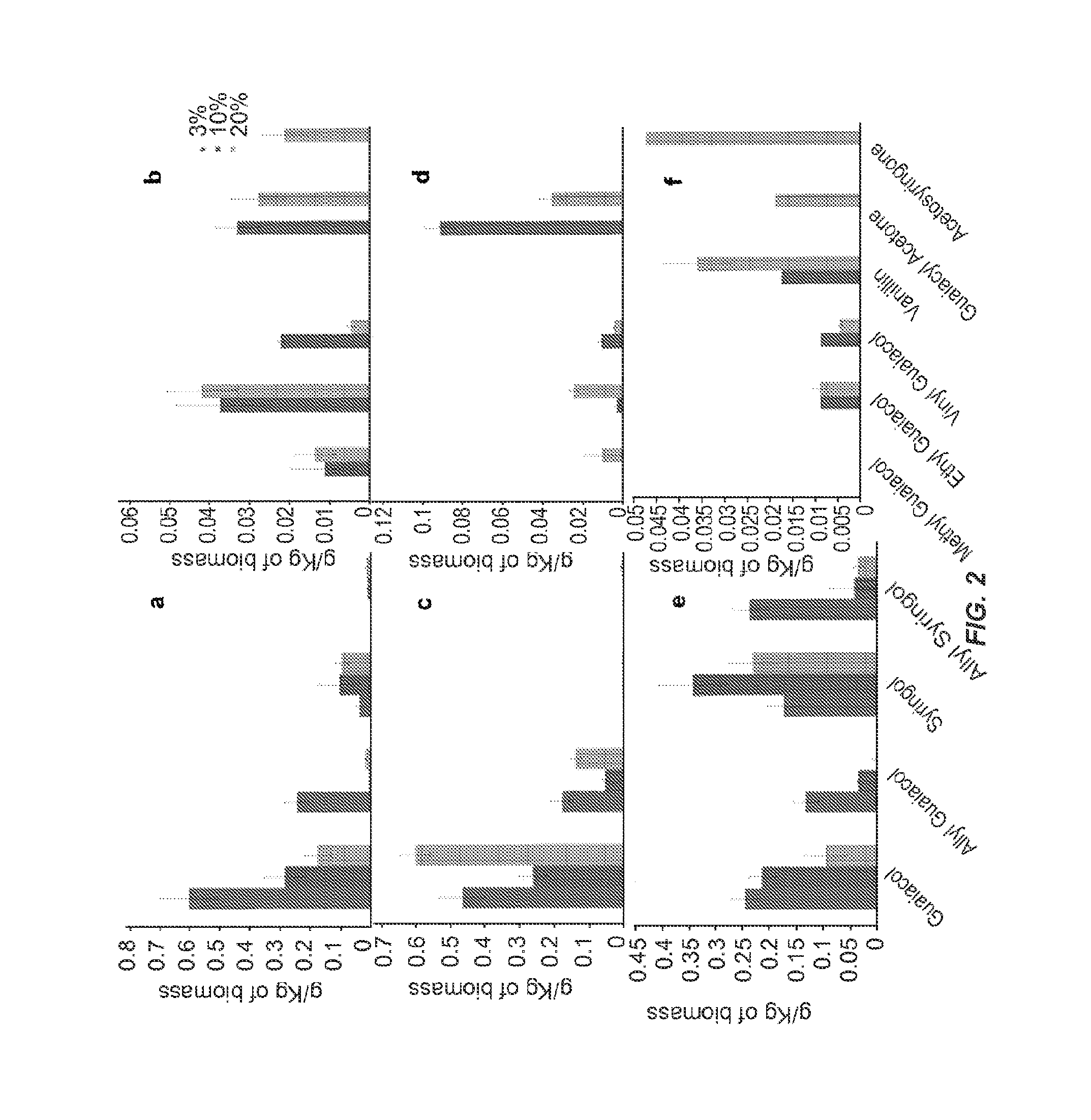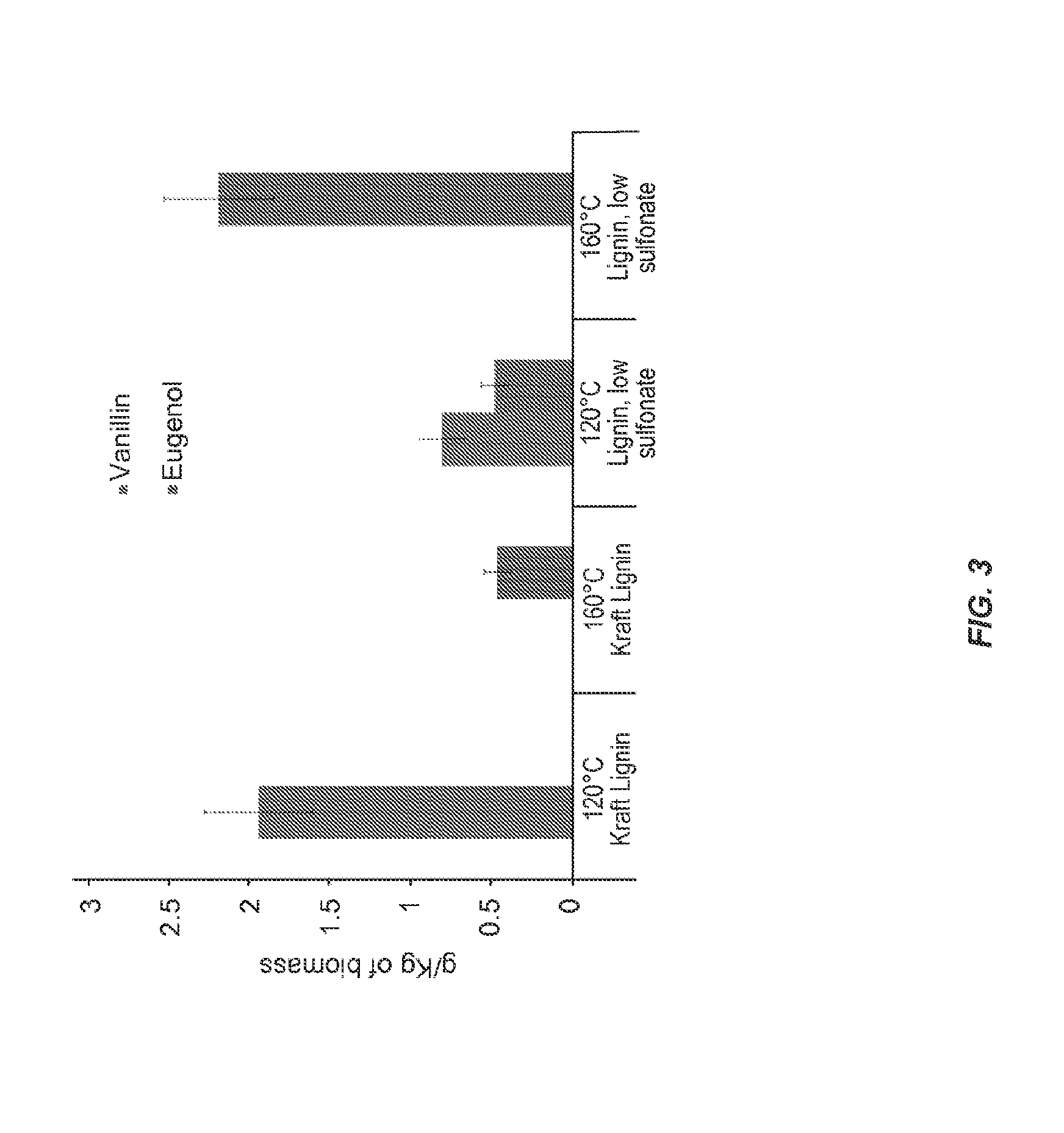Renewable aromatics from lignocellulosic lignin
- Summary
- Abstract
- Description
- Claims
- Application Information
AI Technical Summary
Benefits of technology
Problems solved by technology
Method used
Image
Examples
example i
I.1. Materials
[0054]Kraft lignin was supplied from MeadWestvaco Corp., Richmond, Va. and low sulfonate alkali lignin was purchased from Sigma Aldrich. 1-ethyl-3-methyl imidazolium acetate ([C2mim][OAc], 98%) was used as the solvent to depolymerize and dissolve lignin from the biomass. Benzene was used as the extraction solvent. Guaiacol, ethyl guaiacol, vinyl guaiacol, vanillin, eugenol, syringol, 4-allyl syringol, guaiacyl acetone and 2-methoxy, 4-propenyl phenol were used as standards to confirm the position and the mass to charge ratio of the Gas Chromatography / Mass Spectrometry (GC / MS) peaks. All the chemicals used in this study were purchased from Sigma Aldrich.
I.2 Lignin Dissolution
[0055]Technical lignins were dissolved in [C2mim][OAc] at two different temperatures 160 and 120° C. in a conventional oven (Thelco Laboratory Oven, Jouan Inc, Virginia) for 1, 3, 6 and 12 hrs. Solid loading was held constant at 3 wt % (300 mg in 9.7 mL of [C2mim][OAc]) and components were mixed at ...
example ii
II.1. Materials
[0061]Switchgrass (Panicum virgatum, cultivar MPV2) was provided by the laboratory of Dr. Ken Vogel. Pinus radiata and Eucalyptus globulus was provided by Arborgen. 1-ethyl-3-methyl imidazolium acetate ([C2mim][OAc], 98%) was used as the solvent to depolymerize and dissolve lignin from the biomass. Benzene was used as the extraction solvent. Guaiacol, ethyl guaiacol, vinyl guaiacol, vanillin, eugenol, syringol, 4-allyl syringol, guaiacyl acetone and 2-methoxy, 4-propenyl phenol were used as standards to confirm the position and the mass to charge ratio of the Gas Chromatography / Mass Spectrometry (GC / MS) peaks. All the chemicals used in this study were purchased from Sigma Aldrich.
II.2. Lignin Dissolution
[0062]Biomass was ground to 40 mesh before the dissolution process (Thomas-Wiley Mini Mill fitted with a 40-mesh screen; Model 3383-L10 Arthur H. Thomas Co., Philadelphia, Pa., USA). Biomass was dissolved in [C2mim][OAc] at two different temperatures 160 and 120° C. in...
example iii
III.1. Materials
[0070]Kraft lignin was supplied from MeadWestvaco Corp., Richmond, Va. Low sulfonate alkali lignin was purchased from Sigma Aldrich. Switchgrass (Panicum virgatum, cultivar MPV2) was provided by the laboratory of Dr. Ken Vogel. Samples of Pinus radiata and Eucalyptus globulus were provided by Arborgen. 1-ethyl-3-methylimidazolium acetate ([C2mim][OAc], 98% purity) was used as the solvent to depolymerize and dissolve lignin from the biomass. Benzene was used as the extraction solvent. Guaiacol, ethyl guaiacol, vinyl guaiacol, vanillin, eugenol, syringol. 4-allyl syringol, guaiacyl acetone and 2-methoxy, 4-propenyl phenol were used as standards to confirm the position and the mass to charge ratio of the Gas Chromatography / Mass Spectrometry (GC / MS) peaks. All other chemicals used in this study were purchased from Sigma Aldrich and used as received.
III.2. Lignin Dissolution in IL
[0071]Samples were ground to 40 mesh before the dissolution process (Thomas-Wiley Mini Mill f...
PUM
| Property | Measurement | Unit |
|---|---|---|
| Time | aaaaa | aaaaa |
| Fraction | aaaaa | aaaaa |
| Polarity | aaaaa | aaaaa |
Abstract
Description
Claims
Application Information
 Login to View More
Login to View More - R&D
- Intellectual Property
- Life Sciences
- Materials
- Tech Scout
- Unparalleled Data Quality
- Higher Quality Content
- 60% Fewer Hallucinations
Browse by: Latest US Patents, China's latest patents, Technical Efficacy Thesaurus, Application Domain, Technology Topic, Popular Technical Reports.
© 2025 PatSnap. All rights reserved.Legal|Privacy policy|Modern Slavery Act Transparency Statement|Sitemap|About US| Contact US: help@patsnap.com



